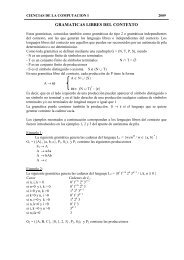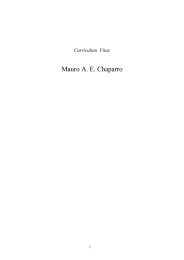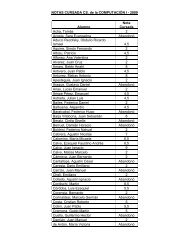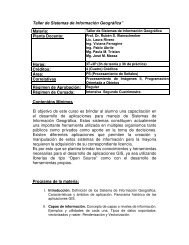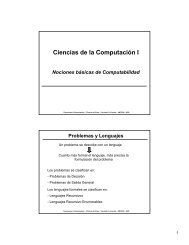Libro de Resúmenes / Book of Abstracts (Español/English)
Libro de Resúmenes / Book of Abstracts (Español/English)
Libro de Resúmenes / Book of Abstracts (Español/English)
Create successful ePaper yourself
Turn your PDF publications into a flip-book with our unique Google optimized e-Paper software.
Resumenes 70<br />
Mo<strong>de</strong>ling the agricultural pest control service provi<strong>de</strong>d by<br />
brazilian free tailed bats (Tadarida brasiliensis) in Texas<br />
The diet <strong>of</strong> Brazilian free-tailed bats (Tadarida brasiliensis) in<br />
southern Texas during the summer inclu<strong>de</strong>s significant proportions <strong>of</strong> major<br />
crop pests in the area such as corn earworm or bollworm (Helicoverpa zea)<br />
and fall armyworm (Spodoptera frugiperda). The significant natural<br />
agricultural pest control service that these bats provi<strong>de</strong> has both a direct<br />
economic impact and an avoi<strong>de</strong>d costs component. We have <strong>de</strong>veloped a<br />
mathematical mo<strong>de</strong>l based on difference equations that <strong>de</strong>scribes bat and<br />
bollworm population dynamics in conventional (without an insecticidal<br />
protein incorporated) and Bt (with Bacillus thuringiensis protein<br />
incorporated) cotton crops in southwestern Texas during the summer. The<br />
mo<strong>de</strong>l focuses on the direct ecological and economic impact <strong>of</strong> bats by<br />
simulating scenarios such as changes in bat population numbers including<br />
total absence <strong>of</strong> bats, different patterns <strong>of</strong> insect migration and pest control<br />
strategies. Number and timing <strong>of</strong> insectici<strong>de</strong> applications, cotton yield and<br />
number <strong>of</strong> insects emigrating from the cotton crops are used as main<br />
response variables to analyze the direct economic impact <strong>of</strong> the bats. A<br />
sensitivity analysis was performed to i<strong>de</strong>ntify parameters <strong>of</strong> large effect.<br />
Then simulations varying these parameters randomly within their possible<br />
ranges were performed. Direct beneficial effects <strong>of</strong> bats on conventional<br />
cotton production inclu<strong>de</strong> situations where one, or sometimes two,<br />
insectici<strong>de</strong> applications can be avoi<strong>de</strong>d; the first application can be <strong>de</strong>layed<br />
by a period <strong>of</strong> a few days; the period between applications increases; the<br />
emigration <strong>of</strong> adult moths out <strong>of</strong> the region is appreciably reduced; and the<br />
number <strong>of</strong> bolls damaged by insects <strong>de</strong>creases significantly. The projected<br />
savings to the conventional cotton producer over a growing season due to<br />
bat consumption <strong>of</strong> pests is, on the average, US$83 per hectare. Given the<br />
mo<strong>de</strong>l assumptions, the bats impact the number <strong>of</strong> insectici<strong>de</strong> applications<br />
nee<strong>de</strong>d in Bt cotton, reducing them by two. The average benefit <strong>of</strong> having<br />
bats foraging above Bt cotton is approximately $40 per hectare. From an<br />
economic perspective and at a local scale, bats have a positive effect on<br />
both conventional and Bt cotton crops. At a broa<strong>de</strong>r scale, the avoi<strong>de</strong>d costs<br />
may be quantified in terms <strong>of</strong> the consumption <strong>of</strong> adult moths by bats,<br />
which significantly reduce the emigrating numbers <strong>of</strong> insects that would<br />
infest crops in northern areas.



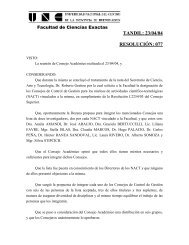
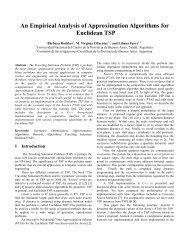
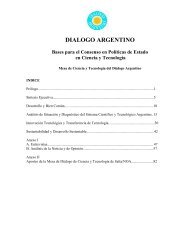
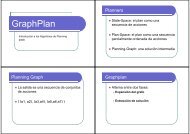
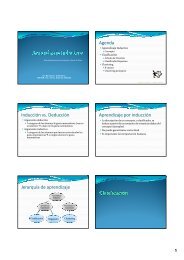
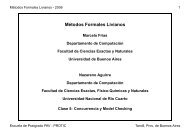
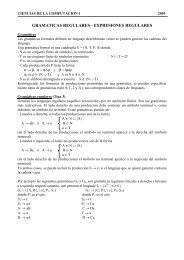
![Clase 13 [pdf]](https://img.yumpu.com/19616969/1/190x245/clase-13-pdf.jpg?quality=85)


